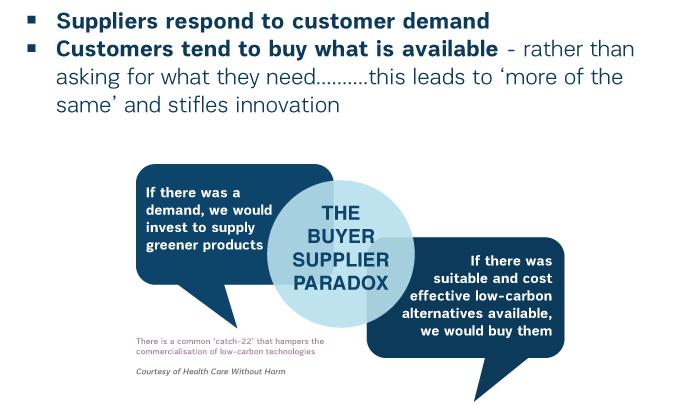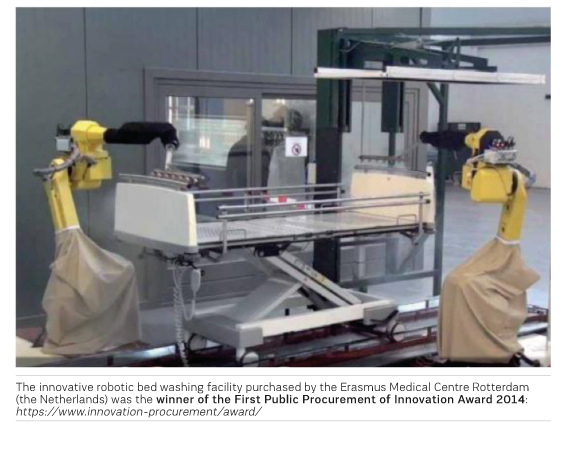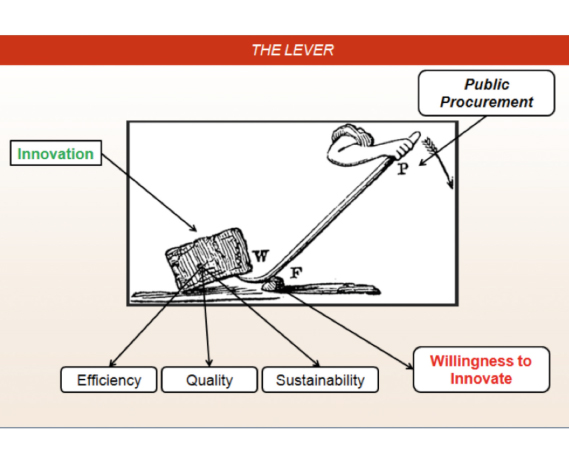HealthManagement, Volume 17 - Issue 5, 2017
Leading to sustainable healthcare solutions
Three pilot studies show how an innovative approach to healthcare procurement can lead to solutions.

For many years, the European Community has been promoting innovation as a fundamental way of enhancing the development of the European Union (EU) and its role in the international arena. Antonio Tajani, President of t he European Parliament and former European Commissioner for Industry and Entrepreneurship, has stated: “European public authorities all have the responsibility to favour innovation when producing and consuming goods and services”.
Inspite of the active support by the European Community (EC), innovation procurement remains a concept that is not sufficiently understood and, consequently, not exploited in its potential for addressing problems and maximising opportunities. This ar ticle concerns specifically the Public Procurement of Innovation (PPI) in Healthcare.
However it can be considered a valid example for any other sector of public functions and services. In fact, compared with all the other public sectors, e.g. public administration, education or justice, the health sector is among the largest contributor to the total amount of public procurement in the EU - estimated by the European Commission at €2 trillion per year.
Therefore it should be considered a potential leader in stimulating innovation through procurement.
This article draws from the experience of a group of hospitals, that undertook to test the Forward Commitment Procurement (FCP) approach to innovation procurement in the EC co-financed project ‘EcoQUIP ’, and to demonstrate how improvements in the efficiency, quality and environmental sustainability of healthcare could be achieved. These pilot projects were under taken in a diverse group o f healthcare organisations across Europe, in Italy, the Netherlands, Poland, UK, as ‘action learning’ projects with the support of expert partners in innovation procurement.
The challenge: delivering better healthcare with fewer resources
EcoQUIP launched with austerity measures in full swing across Europe and when the healthcare sector was already facing the pressures of an aging population and increasing expectations and demands for care services, as well as enormous cost pressures.
At such times, hard-pressed budget holders were inclined to see environmental sustainability as a costly luxury and innovation an unnecessary risk. Still today, many EU Member States (MS) apply policies of so-called ‘spending reviews’. Cuts, however, are not the answer.
EcoQUIP took an alternative path: to work with hospitals and their suppliers to deliver better outcomes, sustainability and cost efficiencies. The tool was ‘innovation procurement’.
“Collectively the pilots carried out by the partners of EcoQUIP demonstrate that better quality, more sustainable services can be provided at lower cost, if procurements provide time and space for innovation,” said Dr Jonathan Frost OBE , EcoQUIP Steering Committee Chairman.
What is innovation procurement?
A detailed description of t he FCP methodology is not the aim of this article. For this we can refer to the many sources available. We will rather focus here on the outcomes and the experience within the case examples, starting by setting out some ‘key principles’.
The three stages of innovation procurement are 1) know what you need and define it in terms of outcomes, not solutions, 2) tell the marketplace in ways that convince them you are a credible customer, 3) finally ensure that your procurement process allows innovative solutions to compete with traditional solutions.
Identification of a credible unmet need
The process starts with an identification of a credible and genuine need. This is often referred to as ‘the commissioning phase’. In innovation procurement stakeholder engagement, from the lower service operators, to top management, is seen as vital to understanding the real unmet needs of the staff, patients and organisation as a whole, ensuring also that the senior management are fully supportive. The identification stage provides a firm foundation for the innovation procurement, yet it is often the stage that is rushed to ‘get tenders out in time’.
Market engagement
The market engagement phase is a ‘pre-procurement’ activity, i.e. it takes place before a formal tendering begins. Its purpose is to assess the appetite, capacity and capability of the market to respond to the customer’s requirements and gives suppliers early warning of forthcoming tenders. It is never used to assess or evaluate suppliers. Successful market engagement requires a pro-active approach on the part of the procurers and for suppliers to believe that the procurers are serious and committed. It helps to determine the procurement strategy that is most likely to deliver the desired outcomes. It is a crucial phase to break down barriers and overcome what is often termed “the Buyer-Supplier paradox”.
EcoQUIP worked to resolve this buyer-supplier impasse by enabling the healthcare customers to accurately identify their unmet needs and then engage with suppliers in a way that stimulates a response. For suppliers it offers an opportunity to be creative and distinguish themselves and their products.
Outcome based specifications: The potential for finding an innovative solution is greatest when customers specify what they want in terms of the desired outcomes that are required from goods or services, rather than a detailed technical specification. The dialogue of the market engagement will not, as traditionally, focus on the specific functional characteristics of a product or a service, but on the needed results not satisfied by existing goods or services and the potential for the supply chain to innovate and respond with new alternatives.
Pro-innovation tendering
Having clearly identified needs, engaged the supply chain, the next step is to ensure that the tendering process is designed to support and enable innovative solutions to be presented and compete on equal terms. Above all, this means adopting non-price based award criteria, i.e. evaluating offers on ‘value’, their total cost of ownership, and not simply ‘price’.
In this regard it needs to be stressed t hat t he EC Directive 2014/24/EU (Eurolex 2017) on public procurement specifically supports innovation.However, barriers remain in many MSs. Innovation procurement requires a new approach to procurement and tendering and many remain unaware or lack the know how to confidently adopt new practices. For this to change, senior management need to offer the leadership and support and recognise the strategic role of procurement within the organisation.
Much of the work of innovation procurement is undertaken in the identification and market engagement stages, before the formal tendering process gets underway. This pre-tender activity creates the necessary conditions for innovation in the customer organisation and supply chain. However, if an innovation procurement project is to succeed this proinnovation approach needs to be continued into the tendering process.
Innovation procurement in action: the pilot projects
EcoQUIP was co-financed in the framework of EC CIP programme by DG GROW — Directorate-General for Internal Market, Industry, Entrepreneurship and SMEs. It was carried out over four-and-a-half years from April 2012 to October 2016 and built on the experience of the pioneering Low Carbon Building-Healthcare (LCB-Healthcare) project.
The pilot projects all had in common the driving need for innovation and fell into two categories:
- Existing service contracts coming to an end and the need for step-change improvements and service transformation
- The Rotherham National Health Service (NHS ) Foundation Trust, Rotherham, UK: people-centred, low carbon catering services for hospitals
- The University Hospital of Bologna (AOSP), Emilia – Romagna Region, Italy: Integrated peoplecentered and environmentally sustainable facilities services
- Problems that needed an innovative solution
- Erasmus MC, Rotterdam, the Netherlands: Sustainable bed-washing facility for a new hospital
- Nottingham University Hospitals NHS Trust, Nottingham UK: Ultra-Low Emission Energy Solution
- Sucha Beskidzka Hospital, Sucha Beskidzka, Poland: Providing thermal comfort for staff and patients while respecting environmental sustainability
Case studies
The Rotherham NHS Foundation Trust
People Centred Low Carbon Catering Services for Hospitals:
Transforming service provision, reducing environmental impact and increasing efficiency.
Situated in South Yorkshire in the north of England, the Rotherham NHS Foundation Trusts (TRFT) Hospital is an acute hospital with around 440 beds that provides services to around 66,000 in-patients and 295,000 out-patients per year.
Through the use of innovation procurement, a new catering contract is now delivering a higher quality catering service, with lower environmental impact and cost savings.


A long-term catering contract coming to an end coincided with the Trusts participation in the EcoQUIP project. The Trust proceeded to re-think its catering requirements in the context of delivering better patient services but also its commitment to procuring progressively lower carbon-catering services. The vision was to obtain “an innovative integrated solution for the provision of high quality patient-appropriate meals that are enjoyable, attractive, support patient recovery and are delivered as an integral part of nursing care”, John Cartwright, Director of Estates and Facilities said on the project objectives. The FCP innovation procurement method was implemented with stakeholder consultation, early engagement with the market, use of outcome specifications, and proinnovation tendering and contract terms.
Feedback from suppliers throughout the project made this approaches an extremely positive step forward in the way such services are procured. The incumbent suppliers immediately began to look at how they could improve the existing service, e.g. reduce plate waste, leading to approximately 2.5% reduction. They also tried alternative service models and ways to improve the patient experience. The Trust remarked “previously, we had only ever asked the catering provider for cost reduction. By putting out a positive requirement to the market it encouraged a creative response and showed that we needed to build a different kind of relationship with the supplier of the new contract. You need to ask for what you want and not assume that better means more expensive.”
The Trust anticipates cost savings of over €1 mln over the first five years of the 5+5 year contract.
Erasmus Medical Centre, Rotterdam, The Netherlands
An advanced robotic bed-washing is a delivering auditable, replicable and green bed-washing.
Erasmus Medical Centre ( Erasmus MC ) is one of eight University Medical Centers in The Netherlands. Erasmus MC's vision is to become a recognised leader in health and healthcare innovation and has a strategic ambition to be a green, low-carbon hospital and to decrease the total amount of energy used in combination with efficient processes in the new hospital.
This pilot project was undertaken in the context of the design, build and equipping of a new 900-bed hospital being built on the same site as the ‘old’ hospital. The project related to the need to purchase a new bed washing facility/solution suitable for use in the new hospital that could wash 70,000 beds every year. After a review of the existing bed washing facility, Erasmus MC decided to explore the ability of the market to supply a solution that met all their requirements. The bed washing solution should be environmentally sustainable, fit-for-purpose, and deliver replicable, consistent and auditable outcomes. The FCP innovation procurement method provided a tool to engage the supply chain in delivering a solution that would meet all these needs.


The project led to the creation of a totally new solution that delivers the required outcomes and has a lower total cost of ownership than the old bed washing facility. Two advanced fully automatic robotic cleaning- units - known as "VMAR Cs" - are now installed and running.
Innovation of ten involves cross fertilisation between supply chains. This solution combines existing proven robotics technologies with new, and newly combined, innovations. Robotic technology, developed for car production lines has been adapted to solve the problem of bed cleaning in hospitals. The technology developed also has wider applications throughout the healthcare sector for resource-efficient precision cleaning of hospital equipment.
Erasmus MC has not only acquired a replicable, consistent and auditable bed cleaning process, but also a more cost-effective solution with a significantly lower environmental impact in comparison with the previous solutions and others, that were already available on the market.
The hospital commented that the product was completely new and developed directly in response to the innovation procurement project to meet the unmet needs of Erasmus MC.
The University Hospital of Bologna (AOSP), Emilia – Romagna Region, Italy
Integrated people-centred and environmentally sustainable facilities services: Transforming service delivery through innovation procurement.
AOSP - The university-hospital complex comprises 27 separate buildings or pavilions over 1.8km2 in the centre of Bologna. It has 1550 beds, 40 of day hospital and provides almost 4 million care, visits, tests to outpatients
This project concerns the radical transformation in the whole hospital complex of ‘soft facility services’, that is all the backroom functions that enable the hospital to maintain high standards of patient care and safety, including cleaning, supply logistics, patient movements, laundry and welcoming.
Historically these services have been provided by different suppliers with activities and tasks being carried out by a combination of external and internal staff. Through an consultative process the project team worked with stakeholders across the hospital to accurately understand the current situation, including the gaps and challenges being faced on a daily basis. Once t his w as clear, stakeholders w ere engaged in defining the unmet needs and developing an outcome-based requirement, that could be communicated to the market. The project was driven by three factors: the current contract was due to end, the hospitals participation in the EcoQUIP project and, later on in the project, the new procurement regulations which encouraged new approaches in support of supply chain innovation, in particular early market engagement.
“It was clear to us that a re-thinking of the soft facility services provision was long overdue, both to address the inefficiencies and failings and bring forward innovation in service delivery and in the tools and techniques used,” said hospital chiefs on t he project.
Carbon reduction was included in the required outcomes of t he tender, requiring progressive improvement over the life of the contract. The project helped to ensure that both management and staff understood and appreciated the relevant contribution that hospital services could give to sustainability, from the reduction of chemicals in cleaning, to correct use of water resources, waste management and recycling.
The market engagement process included the publication of a Prior Information Notice to launch a period of market sounding and a site visit for suppliers. The feedback from the supply chain to the hospitals outcome-based requirement convinced the management t hat t he outcomes they needed were achievable. Given the scale and duration o f the contract, the complexity of the organisational and IT integration and interface aspects, and the novelty of the approach for staff, a pre-tender trial of the new integrated service model was undertaken.
These pre-tender actions helped to design a framework capable of addressing the potential risks of the new approach, for OSP and suppliers, while demonstrating the viability of the new service model. The new contract, with an approximate value of €22 mln a year, is expected to be fully mobilised by mid 2018 and will include progressive improvements and innovation throughout the life of the contract.
Lessons learned
An important lesson from this project is that innovation occurred, not as a result of prior Research & Development (R&D), but as a direct response to the identification and the framing of a previously unmet need in the context of a procurement activity.
It is the prospect of a purchase order that effectively motivates suppliers to invest money, time and effort in R&D that is necessary to produce innovation.
It should be stressed that in case of services, R&D presents different connotations. The basis is analysis, research and testing for which the participation of the day- to-day operating staff, as well as coordinators managers and direct suppliers of the service is essential. Frequently this activity is not sufficiently appreciated and can be qualified as a waste of time. It requires both within the hospital and with the supplier staff the willingness to produce innovation and the belief that it is possible.
It is the new, previously unmet demands, made by the customer that makes innovation natural and necessary. A perhaps surprising outcome of EcoQUIP was the enthusiasm of suppliers for this approach.
Key Points
- Innovation is supported by the EU for commercial advancement
of the bloc but the concept of innovation procurement remains insufficiently
understood and unexploited
- Healthcare is one of the largest contributors to public procurement
in the EU, estimated at €2 trln per year
- The potential for finding an innovative solution is greatest
when buyers specify desired outcomes and the pilots demonstrated this
- New customer demands make innovation natural and Necessary
Dr Simona Agger Ganassi, Architect and Urban Planner, is the Chairman of the Board of EuHPN in which she represents the Italian society of Architecture and Engineering in Health (SIAIS ). The EuHPN is an EU-based foundation promoting better standards and more effective investment in and management of health property throughout the EU.

















